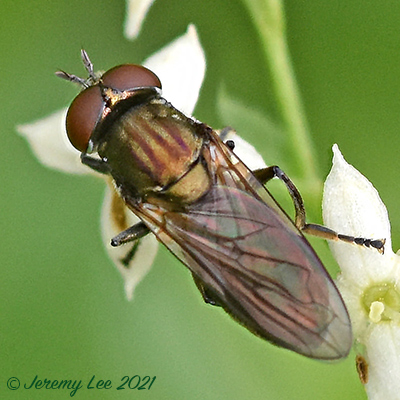
 |
|
Scientific Classifications explained » Amphibians » Ants » Aphids » Bees » Beetles » Birds » Bugs » Butterflies » Caterpillars » Damselflies » Dragonflies » Earwigs » Flies » Frog/Leafhoppers » Fungi » Galls » Grasshoppers » Harvestmen » Hoverflies » Lacewings » Ladybirds » Leaf Mines » Lichens » Mammals » Millipedes » Mosses » Moths » Sawflies » Slugs » Snails » Spiders » Trees & Shrubs » Wasps » Wild Flowers » Woodlice » Postboxes |
UK Nature > Hoverflies > Orthonevra nobilis

Scientific Name: Orthonevra nobilis Common Name: N/A Orthonevra nobilis is easily separated from other three British Orthonevra species by the combination of black legs and elongate 3rd antennal segments. In the field it is smaller than a Chrysogaster or Lejogaster metallina and with a weakly shining bronzy-green and rather shagreened thorax. The recurrent upper outer cross vein that characterises an Orthonevra can just be seen with the naked eye - more easily with a hand lens - and the middle section of the wing has a weak cloud. O. nobilis is our most frequent Orthonevra, a fairly common species in and around marshes, damp meadows and damp woodland rides and clearings. Adults are particularly fond of umbellifer flowers. Larvae develop in wet, organically-enriched mud, especially that associated with springs and flushes. |
|

https://www.uknature.co.uk is a website dedicated to showing the immense diversity of UK nature and wildlife. Our vast range of habitats, from lowland arable to snow covered mountains, from storm-ravaged coastlines to peaceful inland freshwater lakes and rivers, from dry, sandy heaths to deciduous and coniferous forests, all these habitats contribute to the abundance of UK nature. We have wild birds in huge numbers either residing or visiting our shores (597 recorded species as at July 2013) and we must also not forget the humble back garden with its grass lawns, flower beds filled with nectar rich flowers, shrubs and trees, all designed to attract huge numbers of insects such as bees, moths, butterflies and hoverflies; and finally the small ponds which provide safe havens for frogs, toads, newts and even slow worms and grass snakes. www.uknature.co.uk is the showcase for my personal passion, photographing uknature in all its glory. I sincerely hope you all enjoy the fruits of my labours. This site and all images contained therein is © Jeremy Lee 2004 - 2025. All Rights Reserved. Site design by Jeremy Lee. Site development & IT Support by Stuart Lee. |